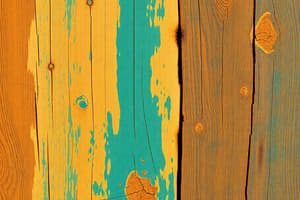Podcast
Questions and Answers
What is the primary function of rays in softwood trees?
What is the primary function of rays in softwood trees?
- Forming growth rings
- Providing structural support
- Storing food and allowing convection of liquids (correct)
- Conduction and support
What is the average time it takes for hardwood trees to mature?
What is the average time it takes for hardwood trees to mature?
- 50 years
- 30 years
- 200 years
- 100 years (correct)
What is a characteristic of softwood trees?
What is a characteristic of softwood trees?
- High-density timber
- Deciduous
- Evergreen (correct)
- Fast-growing
What is the reason for the high demand for sap in hardwood trees?
What is the reason for the high demand for sap in hardwood trees?
What is a result of the slow growth rate of hardwood trees?
What is a result of the slow growth rate of hardwood trees?
Why are hardwoods more expensive than softwoods?
Why are hardwoods more expensive than softwoods?
What is the purpose of preservatives in softwood trees?
What is the purpose of preservatives in softwood trees?
What is a characteristic of the cell structure of hardwoods?
What is a characteristic of the cell structure of hardwoods?
Flashcards are hidden until you start studying
Study Notes
Softwoods
- Evergreen trees with needle-like leaves composed of single cells called tracheids, which provide conduction and support functions.
- Rays in softwoods run radially, perpendicular to growth rings, storing food and facilitating liquid convection.
- Quick growth rate, allowing trees to be felled after 30 years, resulting in low-density timber with relatively low strength.
- Poor durability qualities, often requiring preservative treatment.
- Readily available and relatively cheap due to rapid growth and harvesting.
Hardwoods
- Broad-leaved, deciduous trees that lose their leaves at the end of each growing season.
- Complex cell structure featuring thick-walled fibers for structural support and thin-walled vessels for food conduction.
- Slow growth rate, resulting in high-density timber with high strength, often taking over 100 years to mature.
- Less dependent on preservatives for durability, but often more expensive due to time-consuming growth and transportation costs, as many are tropical.
- Two types of hardwoods: ring porous (with larger vessels formed in springwood) and diffuse porous (with evenly distributed pores).
Studying That Suits You
Use AI to generate personalized quizzes and flashcards to suit your learning preferences.




